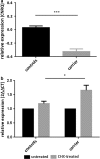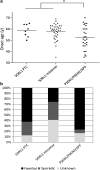A comprehensive study of the genetic impact of rare variants in SORL1 in European early-onset Alzheimer's disease
- PMID: 27026413
- PMCID: PMC4947104
- DOI: 10.1007/s00401-016-1566-9
A comprehensive study of the genetic impact of rare variants in SORL1 in European early-onset Alzheimer's disease
Abstract
The sortilin-related receptor 1 (SORL1) gene has been associated with increased risk for Alzheimer's disease (AD). Rare genetic variants in the SORL1 gene have also been implicated in autosomal dominant early-onset AD (EOAD). Here we report a large-scale investigation of the contribution of genetic variability in SORL1 to EOAD in a European EOAD cohort. We performed massive parallel amplicon-based re-sequencing of the full coding region of SORL1 in 1255 EOAD patients and 1938 age- and origin-matched control individuals in the context of the European Early-Onset Dementia (EOD) consortium, originating from Belgium, Spain, Portugal, Italy, Sweden, Germany, and Czech Republic. We identified six frameshift variants and two nonsense variants that were exclusively present in patients. These mutations are predicted to result in haploinsufficiency through nonsense-mediated mRNA decay, which could be confirmed experimentally for SORL1 p.Gly447Argfs*22 observed in a Belgian EOAD patient. We observed a 1.5-fold enrichment of rare non-synonymous variants in patients (carrier frequency 8.8 %; SkatOMeta p value 0.0001). Of the 84 non-synonymous rare variants detected in the full patient/control cohort, 36 were only detected in patients. Our findings underscore a role of rare SORL1 variants in EOAD, but also show a non-negligible frequency of these variants in healthy individuals, necessitating the need for pathogenicity assays. Premature stop codons due to frameshift and nonsense variants, have so far exclusively been found in patients, and their predicted mode of action corresponds with evidence from in vitro functional studies of SORL1 in AD.
Keywords: Alzheimer; Early onset; Haploinsufficiency; Loss-of-function; Meta-analysis; Rare variants; SORL1.
Figures




Similar articles
-
SORL1 Variants Show Different Association with Early-Onset and Late-Onset Alzheimer's Disease Risk.J Alzheimers Dis. 2017;58(4):1121-1128. doi: 10.3233/JAD-170005. J Alzheimers Dis. 2017. PMID: 28527213
-
Identification and description of three families with familial Alzheimer disease that segregate variants in the SORL1 gene.Acta Neuropathol Commun. 2017 Jun 9;5(1):43. doi: 10.1186/s40478-017-0441-9. Acta Neuropathol Commun. 2017. PMID: 28595629 Free PMC article.
-
Novel Rare SORL1 Variants in Early-Onset Dementia.J Alzheimers Dis. 2021;82(2):761-770. doi: 10.3233/JAD-210207. J Alzheimers Dis. 2021. PMID: 34092641
-
SORL1 genetic variants and Alzheimer disease risk: a literature review and meta-analysis of sequencing data.Acta Neuropathol. 2019 Aug;138(2):173-186. doi: 10.1007/s00401-019-01991-4. Epub 2019 Mar 25. Acta Neuropathol. 2019. PMID: 30911827 Review.
-
Molecular Genetics of Early- and Late-Onset Alzheimer's Disease.Curr Gene Ther. 2021;21(1):43-52. doi: 10.2174/1566523220666201123112822. Curr Gene Ther. 2021. PMID: 33231156 Review.
Cited by
-
An alternative transcript of the Alzheimer's disease risk gene SORL1 encodes a truncated receptor.Neurobiol Aging. 2018 Nov;71:266.e11-266.e24. doi: 10.1016/j.neurobiolaging.2018.06.021. Epub 2018 Jun 28. Neurobiol Aging. 2018. PMID: 30078640 Free PMC article.
-
Investigating the Endo-Lysosomal System in Major Neurocognitive Disorders Due to Alzheimer's Disease, Frontotemporal Lobar Degeneration and Lewy Body Disease: Evidence for SORL1 as a Cross-Disease Gene.Int J Mol Sci. 2021 Dec 20;22(24):13633. doi: 10.3390/ijms222413633. Int J Mol Sci. 2021. PMID: 34948429 Free PMC article.
-
Genome-wide rare variant analysis for thousands of phenotypes in over 70,000 exomes from two cohorts.Nat Commun. 2020 Jan 28;11(1):542. doi: 10.1038/s41467-020-14288-y. Nat Commun. 2020. PMID: 31992710 Free PMC article.
-
Insight into the genetic etiology of Alzheimer's disease: A comprehensive review of the role of rare variants.Alzheimers Dement (Amst). 2021 Feb 20;13(1):e12155. doi: 10.1002/dad2.12155. eCollection 2021. Alzheimers Dement (Amst). 2021. PMID: 33665345 Free PMC article. Review.
-
Protective Variants in Alzheimer's Disease.Curr Genet Med Rep. 2019 Mar;7(1):1-12. doi: 10.1007/s40142-019-0156-2. Epub 2019 Jan 24. Curr Genet Med Rep. 2019. PMID: 33117616 Free PMC article.
References
-
- Andersen OM, Reiche J, Schmidt V, Gotthardt M, Spoelgen R, Behlke J, von Arnim CA, Breiderhoff T, Jansen P, Wu X, et al. Neuronal sorting protein-related receptor sorLA/LR11 regulates processing of the amyloid precursor protein. Proc Natl Acad Sci USA. 2005;102:13461–13466. doi: 10.1073/pnas.0503689102. - DOI - PMC - PubMed
-
- Andersen OM, Schmidt V, Spoelgen R, Gliemann J, Behlke J, Galatis D, McKinstry WJ, Parker MW, Masters CL, Hyman BT, et al. Molecular dissection of the interaction between amyloid precursor protein and its neuronal trafficking receptor SorLA/LR11. Biochemistry. 2006;45:2618–2628. doi: 10.1021/bi052120v. - DOI - PubMed
Publication types
MeSH terms
Substances
LinkOut - more resources
Full Text Sources
Other Literature Sources
Medical

